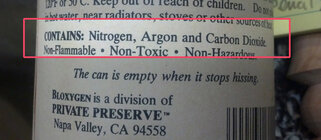Ok. I recently had a thread about cleaning my Nova chuck. My original attempt to clean didn't go well, as I used "odorless" mineral spirits, which don't seem to contain aeromatic compounds, which are the compounds that actually do any real work as a solvent. The remaining compounds in "odorless" mineral spirits stink, and basically do nothing.
I have bought Minwax WOP a number of times...the stuff in the small but tall/narrow can. Its great...with the exception that one the can is half gone, it really LOVES to harden in the can. Just takes a couple of months, and the rest of the can is useless and eventually hardens to a jello-like substance. I use poly a bit, but not a ton, so I tend to lose about a third of a can, maybe a little less, each time.
I read some years back that you could make your own WOP from normal Minwax poly, plus mineral spirits. Well, living in a nanny state, they tell us what we can or cannot do, can or cannot buy, etc. Our masters here have demanded we give up all useful, viable solvents for useless junk. Odorless mineral spirits, as far as I can tell, don't work for jack as a solvent. They seem to keep things liquid, they seem to prevent drying, or at least GREATLY extend drying time instead of the opposite.
SO...given our masters here have taken away all useful solvents, except Turpentine, DNA, and ........well, I think that may actually be it! Will either of those work to thin normal Minwax Poly, in order to make your own WOP? Something that hand spreads more easily, and dries out reasonably fast? Or, am I just out of luck here? The cans of WOP off the shelf are really expensive, like 26.99 for a pint, whereas the normal "warm" cans of poly in quart are $13.99. Thin a quart of poly to 50%, and you would have 4x as much WOP, making the cost of home made like 8x cheaper!
Assuming, that is, you have a solvent that will actually work for the purpose... Any alternatives to true mineral spirits that might work, available in a nanny state?
I have bought Minwax WOP a number of times...the stuff in the small but tall/narrow can. Its great...with the exception that one the can is half gone, it really LOVES to harden in the can. Just takes a couple of months, and the rest of the can is useless and eventually hardens to a jello-like substance. I use poly a bit, but not a ton, so I tend to lose about a third of a can, maybe a little less, each time.
I read some years back that you could make your own WOP from normal Minwax poly, plus mineral spirits. Well, living in a nanny state, they tell us what we can or cannot do, can or cannot buy, etc. Our masters here have demanded we give up all useful, viable solvents for useless junk. Odorless mineral spirits, as far as I can tell, don't work for jack as a solvent. They seem to keep things liquid, they seem to prevent drying, or at least GREATLY extend drying time instead of the opposite.
SO...given our masters here have taken away all useful solvents, except Turpentine, DNA, and ........well, I think that may actually be it! Will either of those work to thin normal Minwax Poly, in order to make your own WOP? Something that hand spreads more easily, and dries out reasonably fast? Or, am I just out of luck here? The cans of WOP off the shelf are really expensive, like 26.99 for a pint, whereas the normal "warm" cans of poly in quart are $13.99. Thin a quart of poly to 50%, and you would have 4x as much WOP, making the cost of home made like 8x cheaper!
Assuming, that is, you have a solvent that will actually work for the purpose... Any alternatives to true mineral spirits that might work, available in a nanny state?



